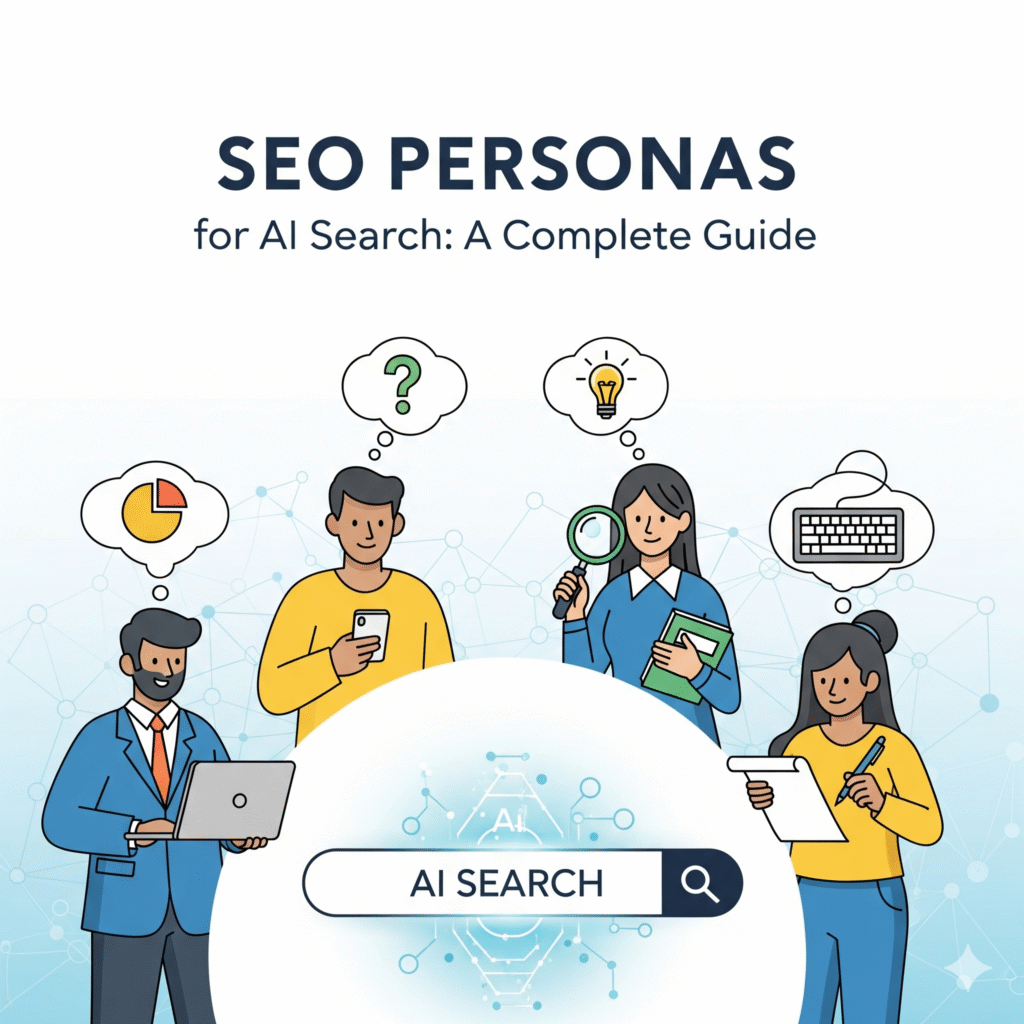You already know how AI-powered search engines like ChatGPT, Gemini, and Bing Chat are changing how people find information online. If you’re still optimizing your content for traditional search engines only, you’re missing a massive opportunity.
Here’s the reality: AI search doesn’t just look for keywords anymore. It tries to understand the person behind the search query. This is where SEO personas for AI search become your secret weapon.
What Are SEO Personas for AI Search?
Think of SEO personas as detailed profiles of your ideal website visitors, but specifically designed for how AI search engines think and respond. Unlike traditional SEO personas that focus on demographics and basic needs, AI search personas dive deeper into conversational patterns, question types, and the context behind searches.
For example, instead of just knowing your audience is “small business owners aged 30-45,” an AI search persona might be “Sarah, a busy restaurant owner who asks specific, problem-solving questions like ‘How do I reduce food waste in my kitchen while maintaining quality?’ She prefers step-by-step solutions and real-world examples.”
Why AI Search Changes Everything
AI search engines don’t just match keywords they interpret intent. When someone asks an AI, “What’s the best way to train a puppy?” the AI considers:
- The user’s experience level (beginner vs. experienced dog owner)
- Their living situation (apartment vs. house with yard)
- Their time constraints
- Their preferred learning style
This means your content needs to anticipate these nuances and speak directly to specific user types.
Key Components of Effective AI Search Personas
1. Conversational Patterns
Understanding how your audience naturally speaks is crucial. AI search engines respond to conversational queries, so your personas should include:
- Question formats they use: “How do I…” vs. “What’s the best way to…” vs. “Can you help me…”
- Language style: Formal, casual, technical, or beginner-friendly
- Context clues they provide: Background information they typically share
2. Intent Categories
Your personas should map to different types of search intent:
- Informational: Seeking knowledge or understanding
- Navigational: Looking for a specific website or page
- Transactional: Ready to make a purchase or take action
- Investigational: Comparing options or researching before deciding
3. Problem-Solution Mapping
AI search excels at connecting problems with solutions. Your personas should clearly define:
- Primary pain points: What keeps them up at night?
- Secondary challenges: Related issues they might not initially mention
- Desired outcomes: What success looks like to them
- Barriers to solution: What’s preventing them from solving the problem
Creating Your AI Search Personas: A Step-by-Step Process
Step 1: Gather Conversational Data
Start by collecting real conversations and queries from:
- Customer service transcripts
- Social media comments and messages
- FAQ sections
- Live chat logs
- Survey responses using open-ended questions
Look for patterns in how people phrase their questions and describe their problems.
Step 2: Identify Question Archetypes
Group similar questions together and identify common patterns:
The Beginner: “I’m new to this and need help understanding…” The Researcher: “What are the pros and cons of…” The Problem-Solver: “I’m dealing with X situation and need…” The Comparison Shopper: “Which option is better for someone like me who…”
Step 3: Build Context Profiles
For each persona, document:
- Background context they typically provide
- Assumptions they make
- Knowledge gaps they have
- External factors influencing their decision
Step 4: Map to Content Types
Different personas need different content formats:
- Visual learners: Infographics, videos, step-by-step images
- Detail-oriented users: Comprehensive guides, case studies
- Quick-answer seekers: Bullet points, summaries, FAQs
- Story-driven users: Examples, testimonials, narratives
Practical Implementation Strategies
Optimize for Conversational Queries
Instead of targeting just “dog training tips,” create content that answers specific conversational queries like:
- “How do I stop my 8-week-old puppy from biting everything?”
- “What’s the easiest way to house train a rescue dog?”
- “Can you help me teach my stubborn dog to come when called?”
Create Persona-Specific Content Sections
Structure your content to serve different personas within the same piece:
- Quick Summary (for the time-pressed professional)
- Detailed Explanation (for the thorough researcher)
- Step-by-Step Guide (for the hands-on learner)
- Common Mistakes (for the cautious planner)
Use Natural Language Patterns
Write as if you’re having a conversation with your persona:
- Use their vocabulary and terminology
- Address their specific concerns
- Acknowledge their constraints
- Provide context for your recommendations
Advanced Techniques for AI Search Success
1. Semantic Clustering
Group related concepts and questions that your personas might have. AI search engines understand relationships between topics, so comprehensive coverage of related subtopics helps your content rank for broader query sets.
2. Context-Rich Content
Provide background information that helps AI search engines understand the full scope of your content. Include:
- Relevant background concepts
- Related terminology
- Common misconceptions
- Prerequisites or requirements
3. Multi-Format Optimization
Create the same core information in different formats to match various persona preferences:
- Detailed articles for researchers
- Quick reference guides for busy professionals
- Video explanations for visual learners
- Interactive tools for hands-on users
Measuring Success with AI Search Personas
Traditional Metrics Still Matter
- Organic traffic growth
- Click-through rates
- Time on page
- Conversion rates
New AI Search Metrics
- Featured snippet captures: How often your content appears in AI-generated responses
- Conversational query rankings: Performance for natural language searches
- Multi-intent coverage: How well your content serves different user intents
- Context relevance scores: How accurately your content matches user context
Persona-Specific KPIs
Track how well your content performs for each persona:
- Engagement patterns by persona type
- Conversion rates for different user intents
- Content format preferences
- User journey progression
Common Mistakes to Avoid
Over-Generalizing Personas
Don’t create personas that are too broad. “Business owners” isn’t specific enough. “SaaS startup founders looking to scale their customer support operations” gives you much more direction.
Ignoring Conversational Context
AI search queries often include context clues. Don’t optimize for just “best CRM software” when users actually search for “best CRM software for a small marketing agency with remote teams.”
Focusing Only on Primary Intent
Users often have secondary questions or concerns. Address the follow-up questions your personas are likely to have.
Neglecting Content Depth
AI search engines favor comprehensive, authoritative content. Surface-level content that only partially answers questions won’t perform well.
Tools and Resources for Development
Research Tools
- Answer The Public: Discover conversational query patterns
- Google’s People Also Ask: Understand related questions
- Reddit and Quora: Find real user questions and language patterns
- Customer interview platforms: Gather firsthand conversational data
Content Optimization Tools
- Natural language processing tools: Analyze your content’s conversational tone
- Semantic analysis platforms: Ensure comprehensive topic coverage
- AI content assistants: Help write in natural, conversational styles
Performance Monitoring
- Google Search Console: Track performance for conversational queries
- AI search monitoring tools: Track appearances in AI-generated responses
- User behavior analytics: Understand how different personas interact with your content
The Future of AI Search Personas
As AI search technology evolves, personas will become even more sophisticated. We’re moving toward:
- Dynamic personas that adapt based on real-time user behavior
- Emotional context recognition in search queries
- Multi-modal search experiences combining text, voice, and visual elements
- Personalized AI responses based on individual user history and preferences
Getting Started Today
You don’t need to overhaul your entire SEO strategy overnight. Start with these actionable steps:
- Audit your current content through the lens of conversational search
- Interview 5-10 customers about how they search for information in your industry
- Create one detailed AI search persona based on your most valuable customer segment
- Optimize one piece of existing content using your new persona insights
- Monitor performance changes and iterate based on results
Conclusion
SEO personas for AI search aren’t just a nice-to-have anymore they’re essential for staying competitive in an AI-driven search landscape. The brands that understand and implement these strategies now will have a significant advantage as AI search continues to grow.
Remember, the goal isn’t to game the system but to better understand and serve your audience in the way they naturally search and ask questions. When you do this well, both AI search engines and human users will reward you with better visibility and engagement.
The future of search is conversational, contextual, and personal. Make sure your content strategy is ready for it.
GET IN TOUCH
Ready to Create Smarter Content?
Most SEO agencies will promise you the world in 30 days. I won’t.
What I will do is spend 30 minutes looking at your website and telling you exactly what’s broken, what’s working, and what you need to focus on first. No sugar-coating, no false promises.
I help businesses use AI-assisted content strategies that balance speed with authenticity so your brand stands out without losing its voice.



Pingback: AI-Assisted Content vs Fully AI-Generated Content: What’s the Difference? - PratsDigital